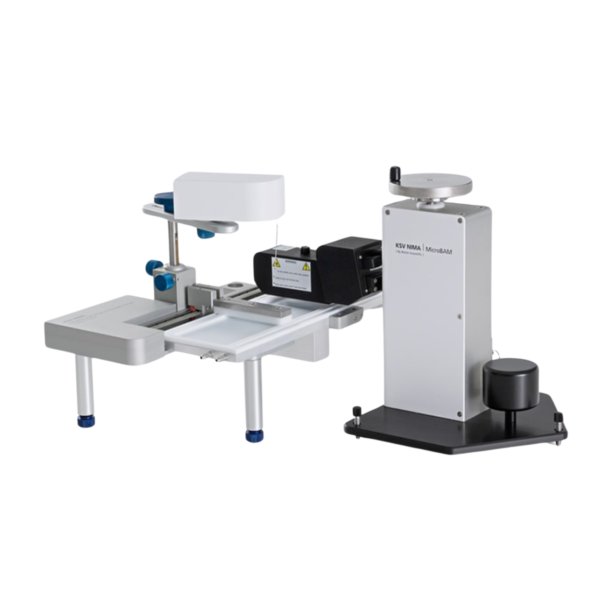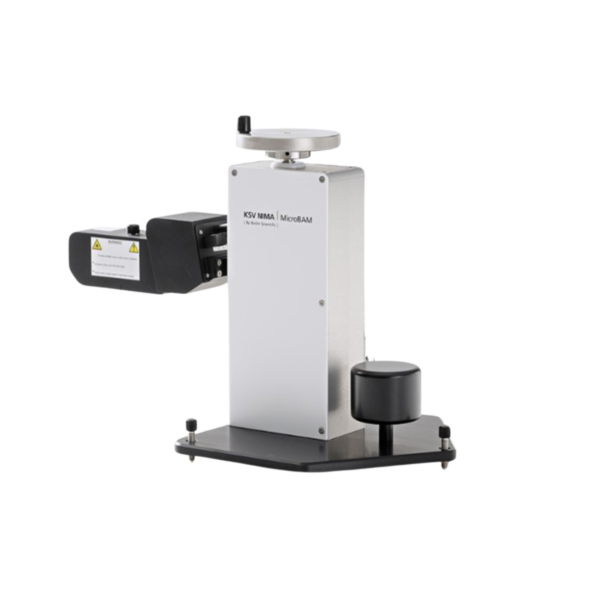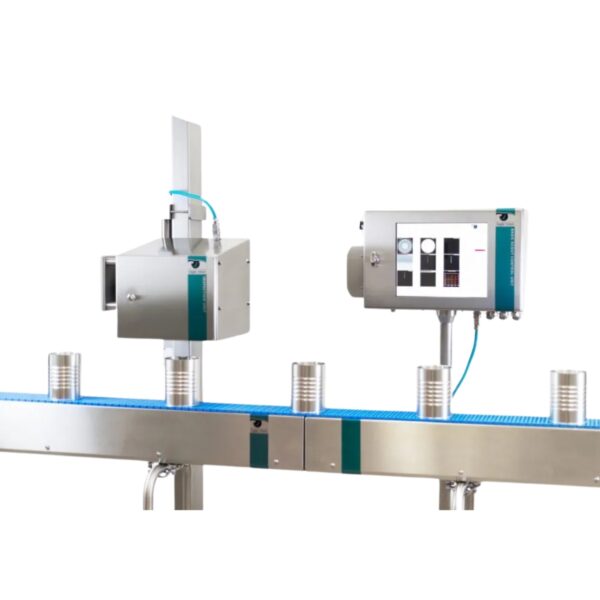Biolin – Deposition & Characterization of Thin Films
KSV NIMA provides instruments and measurement solutions for the fabrication and characterization of advanced organized thin films with controlled packing density.
Available in :
The most common applications include for example depositing highly controlled nanoparticle coatings and studying biological lipid membranes.Key Features
Available Models

Technical Specifications
| Small | Medium | Liquid-Liquid Medium | Large | Liquid-Liquid High Compression | High Compression | Alternate | Roll-to-Roll | |
| Surface area (cm2) | 98 | 273 | 269(197*) | 841 | 580(423*) | 587 | 586 (x2**) | 2330 |
| Trough top inner dimensions (L x W x H mm) | 195 x 50 x 4 | 364 x 75 x 4 | 364 x 74 x 7 (364 x 54 x 10*) | 580 x 145 x 4 | 784 x 74 x 7 (784 x 54 x 10*) | 782 x 75 x 5 | 782 x 75 x 5 (x2**) | 685 x 340 x 4 |
| Maximum compression ratio | 5.2 | 10.8 | 10.8 | 18 | 24.7 | 24.7 | 3.9 | – |
| Barrier speed (mm/min) | 0.1…270 | 0.1…270 | 0.1…270 | 0.1…270 | 0.1…270 | 0.1…270 | 0.1…270 | 0.1…270 |
| Balance measuring range (mN/m) | 0…300 | 0…300 | 0…300 | 0…300 | 0…300 | 0…300 | 0…300 | 0…300 |
| Maximum balance load (g) | 1 | 1 | 1 | 1 | 1 | 1 | 1 | 1 |
| Balance resolution (μN/m) | 0.03 | 0.03 | 0.03 | 0.03 | 0.03 | 0.03 | 0.03 | 0.03 |
| Dipping well dimensions (L x W x H mm) | 20 x 30 x 30 | 20 x 56 x 60 | 20 x 54 x 60 | 20 x 110 x110 | – | – | Half a circle, radius 75; depth 74 | 300 x 300 x 50 |
| Maximum sample size (T x W x H mm) | 3 x 26 x 26 (1 inch) | 3 x52 x56 (2 inches) | 3 x 50 x 56 | 3 x 106 x 106 (4 inches) | – | – | 3 x 30 x 50 (min height 30 mm) | 200 (Substrate width) |
| Dipping speed (mm/min) | 0.1…108 | 0.1…108 | 0.1…108 | 0.1…108 | – | – | 0.1…108 | 1…100 (Substrate roll speed) |
| * The Liquid-Liquid Trough is deeper than a standard trough as this allows for the two liquid phases. The value in the brackets corresponds to confinement of the lower phase (other value for the upper phase). ** The Alternate-Layer Deposition Trough is made of two separated compartments for creation of two monolayers simultaneously. – : Not available/Not applicable |
What you can do
- Create functional coatings with nanoparticles (altering e.g. wettability, reflectivity, biocompatibility, conductivity, binding properties etc.)
- Form model cell membranes at air-buffer interfaces and study the effects of toxins or pharmaceuticals on the cell membrane
- Form thin polymer films for the study of polymer crosslinking, stability, degradation etc.
- Study the interactions, adsorption, desorption, interfacial stability and structure of amphiphilic molecules
- Interfacial rheological studies to determine film stability, phase transitions or reactions
Key Features
The Langmuir and Langmuir-Blodgett technologies have unique advantages leading to extensive usage of the method worldwide. These benefits include:
- Precise control of molecular packing density
- Precise control of coating thickness
- Homogeneous deposition over large areas
- Enables multilayer structures with varying layer composition
- High flexibility in using different kinds of particles and substrates
- Coating quality can be pre-monitored prior to deposition

Technical Specifications
| LB Medium Trough | |
| Surface area (cm2) | 273 |
| Trough top inner dimensions (L x W x H mm) | 364 x 75 x 4 |
| Maximum compression ratio | 10.8 |
| Barrier speed (mm/min) | 0.1…270 |
| Balance measuring range (mN/m) | 0…300 |
| Maximum balance load (g) | 1 |
| Balance resolution (μN/m) | 0.1 |
| Dipping well dimensions (L x W x H mm) | 20 x 56 x 60 |
| Maximum sample size (T x W x H mm) | 3 x52 x56 (2 inches) |
| Dipping speed (mm/min) | 0.1…108 |
What you can do
- Get precise control of the thin film thickness and packing density
- Create homogeneous depositions over large areas
- Add your coating to any solid substrate
- Build multilayer structures with varying layer composition
Outstanding Versatility
Ambient method to coat any solid substrate with any floating nanomaterials such as nanoparticles or graphene oxide.
See Your Film
The MicroBAM microscope lets you see your film prior to the deposition, ensuring optimal quality and homogeneity of your coating and reducing time spend on measurements.
Maximum Value
The package brings you maximal value to acquire several technologies to your lab on one go.

Technical Specifications
| Sample Specifications | Small | Medium | Large |
| Weight (g) | 0…150 | 0…500 | 0…500 |
| Height (mm | 15…140 | 25…300 | 25…500 |
| Width (mm) | 5…150 | 5…400 | 5…400 |
| Thickness (mm) | 0.15…3 | 0.15…15 | 0.15…15 |
| Number of samples | 1, 2*, 3* | 1, 6*, 10* | 1, 6*, 10* |
| Other Instrument Specifications | |||
| Dipping speed (mm/min) | 0.1…100, 0.2…200* | 1…1000 | 1…1000 |
| Dimensions (L×W×H, mm) | 275×154×420 | 490×410×1200 | 490×410×1800 |
| * Optional |
KSV NIMA Dip Coaters are designed to deposit layers of materials in a controlled and repeatable manner. Films of various thicknesses can be deposited, from monolayers to multilayered structures. Automated dippers are well suited to situations when deposition is based on kinetic factors and where good control is needed. For multilayer deposition, multi vessel dipping enables automated deposition with good reproducibility.
The dip coaters ranges from compact instruments for coating small samples in a single vessel to more complex systems enabling horizontal and vertical movement for multi vessel operations and coating of large samples.
The dip coaters are divided into two types: single and multi vessel systems. Single vessel dip coaters are used to deposit from one solution while the multiple vessel dip coaters enable many solutions to be used including cleaning or rinsing. The single vessel and multi vessel categories feature small, medium and large systems to support a large range of sample sizes. A single vessel dip coater is also available for extra large samples. You can choose from dip coater systems suited to sample weight, sample size, number of samples, dipper movements and number of vessels required.
What you can do
- Multilayer sensor coatings
- Implant functionalization
- Hydrogels
- Sol-gel nanoparticle coatings
- Self-assembled monolayers
- Layer-by-layer nanoparticle assemblies

Technical Specifications
| Measurement | KSV NIMA MicroBAM |
| Angle-of-incidence range (°) | 53, fixed |
| Light source power (mW) | 50 |
| Light source wavelength (nm) | 659 |
| Image resolution (µm) | 12 (horizontal image direction, center)1 |
| Field of view (µm) | 3600×4000 |
| Polarizer | Integrated (p-polarisation of the incident beam) |
| Analyzer | Integrated |
| Hardware | |
| Instrument dimensions (L×W×H, cm) | 22×27.7×40.2 |
| Measuring head dimensions (L×W×H, cm) | 5.7×16.2×7.2 |
| Power supply (V, Hz) | 100-240, 50/60 |
| Weight (kg) | 10 |
| 1According to Rayleigh’s criterion |
The KSV NIMA MicroBAM is an easy-to-use instrument for non-invasive imaging of mono-molecular layers at the air-water interface.
By detecting changes in the refractive index of the water surface in the presence of surfactant molecules, MicroBAM provides information on homogeneity, phase behavior and film morphology without the need for any external agents such as fluorescent dyes which could interfere with the Langmuir layer.
The good image quality and lateral resolution make it an ideal instrument for the visualization of morphological film parameters (e.g. compressed film homogeneity, domain size, shape and packing). Real-time observation and recording of film structure enables dynamic activity to be captured.
The KSV NIMA MicroBAM can be used with most KSV NIMA Langmuir and Langmuir-Blodgett Troughs, to provide real-time image measurements as a function of time or surface pressure. The KSV NIMA MicroBAM connects directly to the computer via USB making it remarkably easy to setup and use.
What you can do
- Pre-deposition Langmuir-Blodgett layer quality check
- Monolayer/film homogeneity. When combined with a KSV NIMA L&LB Trough, observation can be performed during compression/expansion at known surface pressures. Verifying the homogeneity of the monolayer already prior to deposition will speed up the research considerably.
- Optimizing the deposition parameters. For a high quality LB coating, the measurement parameters such as compression speed, waiting times, temperature and subphase content need to be optimized. With MicroBAM it is easy to study the effects of these parameters and choose the optimal conditions.
- Langmuir layer structure and behavior studies
- Monolayer/film behavior. It is possible to observe phase changes, phase separation, domain size, shape and packing.
- Monitoring of surface reactions. For example, photochemical reactions, polymerization reactions as well as enzyme kinetics can be followed in real-time.
- Monitoring and detection of surface active materials. For example protein adsorption and nanoparticle flotation.

Technical Specifications
| Measurement | KSV NIMA SPOT |
| Input range | -5V to +5V |
| Sensitivity | #ERROR! |
| Height dependency | 10mV/mm |
| Response time | Proportional to distance but less than 1s when positioned 1 mm above monolayer |
| Calibration | Factory calibrated |
| Hardware | |
| Measuring head dimension | 100x85x20mm |
| Probe diameter | 16mm |
| Stand base height | 19mm |
| Maximum sensor height | 160mm |
| Counter-electrode plate dimensions | 35x50x2mm |
| Vertical electrode arm length | 20mm |
The KSV NIMA Surface Potential Sensor is used for determining molecular orientation changes in Langmuir films. Together with the surface pressure sensor included in all KSV NIMA Langmuir and Langmuir-Blodgett Troughs, it gives an in-depth view of the Langmuir monolayer interactions.
The instrument measures the potential difference above and below the film and is sensitive to the sum of all the individual dipole moments. The changes in surface potential are measured by detecting the potential difference between the vibrating plate, which is placed above the monolayer, and the counter electrode, which is immersed in the sub-phase below the monolayer.
The sensor allows complementing data from surface pressure—area isotherm measurements obtained from a Langmuir and Langmuir-Blodgett Trough. It allows the determination of monolayer composition, molecular orientation, degree of molecular dissociation and molecular interactions at the interface.
The Surface Potential Sensor is recommended for use with a KSV NIMA Langmuir and Langmuir-Blodgett or Microscopy Trough to enable combined surface pressure and surface potential measurements. The SPOT can also be used with other troughs together with a KSV NIMA Interface unit.
What you can do
- Determine molecular orientation. The SPOT provides information about molecular orientation by observing changes in surface potential and combining the data with surface pressure information.
- In-depth view of Langmuir layer interactions. Surface pressure isotherm alone is unable to separate the reasons for surface pressure changes. Combined with the SPOT, the data gathered from the layer is doubled, giving an in-depth understanding of the layer.
- Determine effective dipole moments. The sensor can be used to determine effective dipole moments through simple surface potential measurements of a compressed film.
- Characterize film electronic structure. Small changes in the electronic structure of molecules can be detected by measuring the change in surface potential.
- Characterize molecular structure. Quantify the effects of changes to molecular structure through positional offsets and peak values of the surface potential plots.
- Monitor complex formation. Observe and follow complex formations between monolayers, sub-phase species or adsorbates.

Technical Specifications
| Measurement | ISR Flip |
| Frequency range (Hz) | 0.01 – 10 |
| Dynamic moduli range (N/m) | 2×10-8 – 1 |
| Dynamic moduli resolution (N/m) | 1×10-8 |
| Strain range (%) | 0.04 – 20a |
| Instrument | |
| Camera | USB 3.0 digital camera with zoom |
| Camera resolution | 1980 x 1200 |
| Field of view (Φ, mm) | 4.7 mm x 2.93 mm / 0.73 mm x 0.45 mm |
| Instrument dimensions (LxWxH, mm) | 400 x 280 x 600 |
| Weight (kg) | 21 |
KSV NIMA ISR Flip is used to study interfacial viscoelasticity of the thin films. The method is based on shear deformation. The measurement is performed with the help of a magnetized probe. The probe is oscillated at the air-liquid or liquid-liquid interface using the mobile magnetic trap. The movement of the probe is recorded with a high-resolution camera, and the viscoelastic properties of the film can be calculated.
Product Range
ISR Flip can be equipped with either ISR Flip high compression trough or a low volume cell. The ISR Flip high compression trough enables simultaneous control of the packing density of the thin film, whereas low volume cell is more suitable when amount of thin film material is limited or the subphase volume needs to be reduced.
Both systems enable surface pressure measurement thanks to the integrated highly sensitive Wilhelmy balance. The ISR Flip high compression trough and the Low volume cell are divided into an upper and lower compartment, which can be used to study film viscoelasticity at the liquid-air or liquid-liquid interface.
ISR Flip is designed for easy injection of the chemicals to enable real-time chemical interactions studies. For example, the low volume cell has two injection ports at each end of the cell to enable easy injection of materials (e.g. proteins, enzymes) in the subphase and to allow gradual subphase exchange while measuring.
What you can study
Applications controlled by interfacial rheology, including:
- Biological systems such as pulmonary lung surfactant and meibum. Their functionality is largely based on their flow on interphases under stress.
- Emulsions and foams whose stability is vital for their functionality. Viscoelasticity of the liquid-liquid interface can predict the stability of a colloidal system. Micelle/droplet fusion and fission are largely dependent on the interface viscoelasticity.
- Food products, cosmetics, biophysics, pharmaceuticals, oil and gas, application areas where molecules at interfaces have a significant impact on the system performance.
Langmuir monolayer structural studies, including:
- Phase changes, as the viscoelasticity of the layer is strongly affected by the microstructure of the monolayer.
- Surface reactions such as crosslinking in real-time, as changes in molecular size and shape have typically a strong response in their rheological properties.
- Aggregation and adsorption, as they typically change the viscoelasticity of the film.
Langmuir and Langmuir-Blodgett Troughs
MicroBAM Characterization of thin films KSV NIMA
ISR Flip from KSV NIMA
Key Features
- Precise control of molecular packing density
- Precise control of coating thickness
- Homogeneous deposition over large areas
- Enables multilayer structures with varying layer composition
- High flexibility in using different kinds of particles and substrates
- Coating quality can be pre-monitored prior to deposition
Biolin Scientific is a worldwide company making state of the art instruments and smart solutions for scientists. Knowledge is our…
-
Biolin Langmuir&Langmui-Blodgett Brochure
-
Biolin Nanoparticle Deposition Brochure
-
Biolin MicroBam Brochure
-
Biolin Surface Potential Sensor Brochure
-
Brochure ISR Flip Brochure
-
INDONESIA
PT. DKSH Market Expansion Services Indonesia
AIA Central 39th floor. Jalan Jenderal Sudirman Kavling 48A
12930 Jakarta Selatan
Indonesia+62 21 2988 8557
+62 21 2988 7870
-
AUSTRALIA
DKSH Australia Pty Ltd
1 Beyer Road
3195 Braeside VIC
Australia
-
MALAYSIA
DKSH Technology Sdn. Bhd.
B-11-01, The Ascent, Paradigm, No. 1, Jalan SS7/26A, Kelana Jaya
47301 Petaling Jaya, Selangor
Malaysia
-
NEW ZEALAND
DKSH New Zealand Limited
33 Westpoint Drive
0618 Hobsonville, Auckland
New Zealand
-
THAILAND
DKSH Technology Limited (Head Office)
2533 Sukhumvit Road, Bangchak, Phrakhanong
10260 Bangkok
Thailand
Download now
How to Disable Pop-Up Blockers for Smooth Downloads
Google Chrome (Version 110 and later):
- Click the three dots (menu) in the top-right corner and select Settings.
- Under Privacy and Security, click Site settings.
- Scroll down to Content and click Pop-ups and redirects.
- Toggle the switch to Allowed or add https://technology-products.dksh.com to the Allow list.
Mozilla Firefox (Version 90 and later):
- Click the three horizontal lines (menu) in the top-right corner and select Settings.
- Go to the Privacy & Security section.
- Scroll to Permissions and uncheck Block pop-up windows for https://technology-products.dksh.com.
Microsoft Edge (Version 110 and later):
- Click the three dots (menu) in the top-right corner and select Settings.
- Scroll down to Cookies and site permissions.
- Under Site permissions, click Pop-ups and redirects.
- Toggle the switch to Allow or add https://technology-products.dksh.com to the Allow list.
Safari (Version 14 and later):
- Open Safari and go to Preferences (from the top menu).
- Select the Websites tab.
- Under Pop-up Windows, select Allow for https://technology-products.dksh.com.











